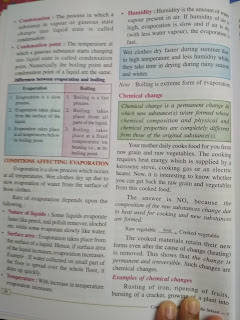EXERCISE QUESTION
Copy the
question and answer in Chemistry copy.
Q.1. What do you observe when:
i.
Water
is boiled?
Ans.: Water changes to steam.
ii.
A
piece of paper is burnt?
Ans.: The paper turns into ash.
iii. Some
ice cubes are kept in glass tumbler.
Ans.: The ice melts and changes to
liquid water. Water droplets are formed on the outer surface of the glass
tumbler.
iv.
Quicklime is dissolved in water?
Ans.: A lot of heat is evolved.
Quicklime dissolves in water to form an alkaline solution called lime water.
v. Solid
ammonium chloride is heated?
Ans.:
The white crystalline solid (ammonium chloride) sublimes on
heating to form dense white fumes. The dense white fumes form a powdery mass on
the cooler parts of the test tube. No residue is left behind.
vi.
An
iron nail is kept in tap water for few days?
Ans.: The iron nail undergoes rusting. A
reddish brown powdery substance is formed on the nail.
vii.
A
lighted match stick is brought near the mouth of test tube containing hydrogen
gas?
Ans.:
The lighted match stick extinguishes and hydrogen gas burns with blue flame and a pop sound.
viii.
A
spoon of sugar is heated in a pan?
Ans.:
The sugar first melts and then changes its colour to reddish brown. On strong
heating a black charred mass of carbon is formed. A colourless, odourless gas
which turns lime water milky is evolved.
----------------------------------------------------------------------------------------------------------------------------------------------------------
Melting Point
It
is the temperature at which a solid changes to a liquid under normal pressure.
The melting
point is the characteristic property of solids. The melting point of a solid is
indication of the strength of the force of attraction between particles.
Freezing Point
It
is the temperature at which a pure liquid changes to a solid at atmospheric
pressure. The melting point and freezing point are same. Hence freezing point
is also affected by change in pressure and presence of impurities.
Boiling Point
It
is the temperature at which a pure liquid changes to vapour under normal
pressure. Boiling point is the
characteristic property of a liquid.

GAS AND VAPOUR
A
substance which exists in the solid or liquid state under ordinary conditions
but under certain conditions it exists in gaseous state is called vapour.
A substance
which exists in the gaseous state under ordinary conditions i.e. at room
temperature and one atmospheric pressure is called a gas.
EVAPORATION
The
process of conversion of a substance from the liquid state to its vapour state
at any temperature below its boiling point is called evaporation. It is a
surface phenomenon. Evaporation causes cooling.
Factors
on which the Rate of Evaporation of a Liquid Depends
1. Surface area of the liquid: Larger the
exposed surface greater is the rate of evaporation.
2. Temperature: The rate of evaporation is
directly proportional to temperature.
3. Humidity: Lower the humidity greater is
the rate of evaporation.
4. Nature of liquid: Some liquids evaporate
faster like alcohol while some evaporate slowly.
5. Speed of Wind: The rate of evaporation
increases with speed of wind.














Comments